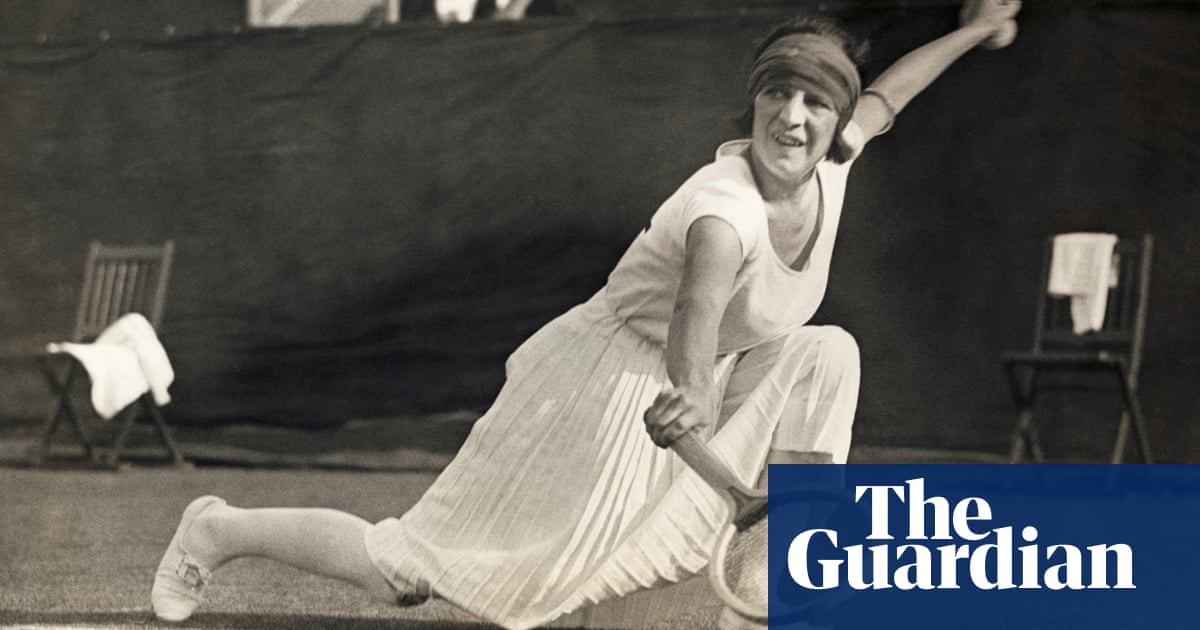Court couture: why tennis fashion owes it all the Suzanne Lenglen - 5 minutes read

Before the French tennis star Suzanne Lenglen boarded an ocean liner in 1926 to take her to New York (where she would embark on the lucrative tour of the US that arguably established tennis as a profession), she was asked about her level of fitness.
“I don’t know,” she replied. “I haven’t played for months.” Instead, she said, she had been shopping. “You should see this black and white evening dress of mine. It’s a masterpiece.”
It was a response typical of the glamorous Lenglen, after whom the second largest court at the French Open’s Stade Roland Garros is named. A court which, over the past week, has seen drama as American Taylor Fritz returned the goading of a raucous crowd, and where the surprise finalist Karolina Muchova played.
Lenglen, known as La Divine, was the world’s first global sporting celebrity, her fame eclipsing that of even baseball’s Babe Ruth or boxing’s Jack Dempsey. During seven years as the world No 1, she won the singles title at Wimbledon six times, did the “triple” at the French Championships twice (singles, doubles and mixed doubles), took gold at the 1920 Olympics, and lost just a single match throughout her short post-first world war career (she retired from the match with illness, controversially).
But Lenglen, who was born in Paris in 1899 and spent her summers on the French Riviera where she honed her skills under the tutelage of her often-tyrannical father, did not conquer the world solely by her athletic ability (although Debussy did compose a ballet influenced by her prowess). Her charisma, unorthodox charm and hedonism helped keep her in gossip columns, but it was her sense of style that had an impact as great as her on-court talent and epoch-making career path.
In an era in which women’s sporting “costumes” were cumbersome and restrictive in the name of modesty, Lenglen dispensed with corsets and petticoats. The first Wimbledon fashion scandal – of which there have been many owing to the All England Club’s vigorous sartorial rules – saw Lenglen arriving for her 1919 debut in a low-cut dress and rolled-down stockings; an outfit the London press deemed “indecent”.
Suzanne Lenglen at Wimbledon in 1925. Photograph: Everett Collection Historical/AlamyThough she had worn a floppy hat on that occasion, Lenglen would introduce her signature garment not long after: the much emulated bandeau headscarf. Lenglen’s original take saw her wrap two yards of colourful silk chiffon around her neat flapper’s bob. Sometimes the bandeau would be polka dot, or adorned with diamonds; at other times, she colour-coded it to whichever round she was playing: orange for first, crimson for second.
She wore fur coats and ermine stoles to matches, and would sip cognac with bright red painted lips during changeovers. Her short-sleeved dresses gave way to sleeveless. The result: a deep tan she popularised even before Coco Chanel’s 1923 yacht trip. In collaboration with the Parisian courtier Jean Patou, whose muse she served as and who dressed her on and off the court, Lenglen was the poster girl for an avant garde sports casual style. The look became de rigueur in the 20th century for the upper classes, before being democratised, and is commonplace today (as well as presaging athleisure, though I refuse to blame Lenglen for Lululemon).
Patou, dubbed the “most elegant man in Europe”, later dressed Lenglen in a freeing, calf-length pleated skirt in which to play, a garment that crossed into everyday wear.
Lenglen’s influence on the shifting status of tanned skin saw a renaissance in the design of swimsuits, which exposed greater and greater amounts of skin. Her trademark white plimsolls inspired unisex “Lenglen shoe” spin-offs – a precursor to the Adidas Stan Smith – which retailers called “light, elegant, and practical”. The female form was becoming liberated. The British tailor John Redfern was perhaps the first to design sports-specific wear for women in the 1870s, but it was Patou and Lenglen and the more androgynous, comfortable fits of Coco Chanel, in particular, that saw it take hold.
skip past newsletter promotionSign up to Fashion StatementStyle, with substance: what's really trending this week, a roundup of the best fashion journalism and your wardrobe dilemmas solvedPrivacy Notice: Newsletters may contain info about charities, online ads, and content funded by outside parties. For more information see our Privacy Policy. We use Google reCaptcha to protect our website and the Google Privacy Policy and Terms of Service apply.after newsletter promotionPerhaps thanks to aristocratic and wealth-adjacent roots like Lenglen’s, tennis has always been the sport closest to fashion, whether haute or pret-a-porter. But nowadays, mid-range labels of past celebrated players such as Fred Perry and Rene Lacoste (Lenglen’s close friend ) are long established, and not a single style blog circa 2015 was complete without Stan Smiths. Emma Raducanu might have signed deals with high-end brands such as Dior, and Rolex has a collection with Roger Federer, but Bjorn Borg has a range of underpants, and Rafa Nadal’s Nike gear is stocked in Sports Direct.
Tennis is still by far the most stylish sport, in my opinion (with cricket taking second place – no disrespect to Premier League footballers dressed head-to-toe in DSquared2). I feel the umpires in tailored blazers and chinos at Roland Garros are clear evidence of this; those who worked the Suzanne Lenglen court participating in a homage to an inspiration both inside and outside the lines.
Remember that every time you see progress in the utility of women’s sportswear we have Lenglen and Patou to thank, just as every time you are shoulder-robing a cashmere cardigan, being peak chic, you should pay your dues to them, too. Game, set, Matches.
Source: The Guardian
Powered by NewsAPI.org